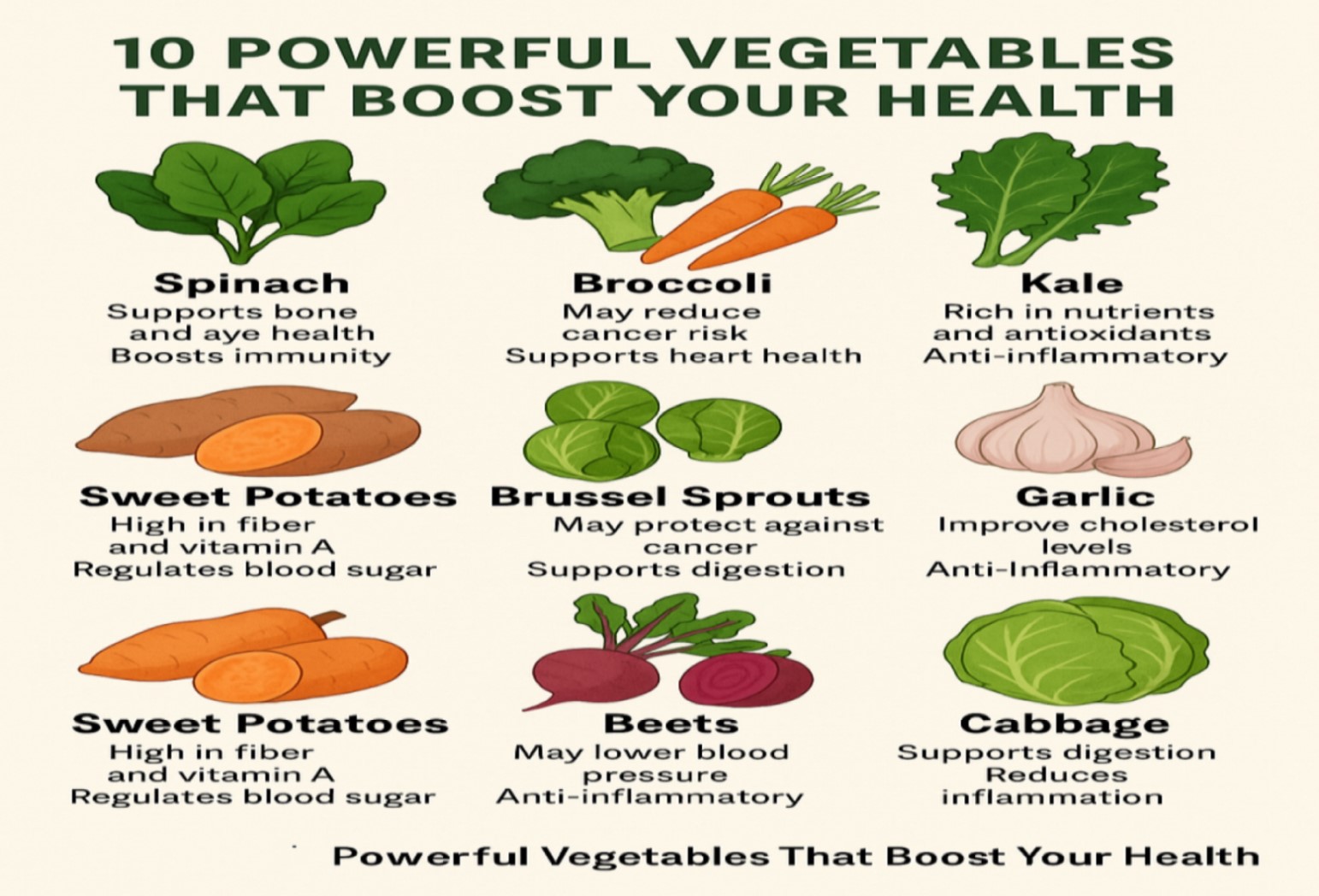Vegetables are nature’s most nutritious gift. Packed with vitamins, minerals, fiber, and antioxidants, they play a key role in disease prevention and overall wellness. Here are 10 of the healthiest vegetables, each with unique health benefits and delicious ways to add them to your meals.
The 10 vegetables: Spinach, Broccoli, Carrots, Kale, Garlic, Sweet Potatoes, Brussels Sprouts, Beets, Bell Peppers, and Cabbage
1. Spinach
Nutrients:
-
Rich in iron, magnesium, potassium, and folate
-
High in vitamins A, C, K1, and B2
-
Contains powerful antioxidants like lutein and zeaxanthin
Health Benefits:
Spinach supports healthy skin, hair, and bones. Its iron content makes it valuable for red blood cell production, while its antioxidants promote eye health and may reduce the risk of macular degeneration.
How to Eat:
-
Add fresh spinach to salads or smoothies
-
Sauté with garlic as a side dish
-
Stir into soups and omelets
2. Broccoli
Nutrients:
-
High in vitamin C, vitamin K, and fiber
-
Contains sulforaphane and other cancer-fighting compounds
Health Benefits:
Broccoli helps boost the immune system, supports healthy bones, and may help lower the risk of certain cancers. It also supports gut health and detoxification.
How to Eat:
-
Steam or roast as a side
-
Toss into stir-fries
-
Blend into creamy soups
3. Carrots
Nutrients:
-
Excellent source of beta-carotene (vitamin A), biotin, and fiber
-
Contains antioxidants like lutein and anthocyanins
Health Benefits:
Carrots are famous for promoting eye health. They also support immune function, improve skin health, and may help regulate blood sugar due to their fiber content.
How to Eat:
-
Snack raw with hummus
-
Roast with olive oil and herbs
-
Grate into salads or muffins
4. Kale
Nutrients:
-
High in vitamins A, C, and K
-
Rich in calcium, copper, and antioxidants like quercetin
Health Benefits:
Kale is a true superfood. It helps reduce inflammation, strengthens bones, and supports heart health. Its antioxidant compounds may also provide anti-cancer benefits.
How to Eat:
-
Massage into salads
-
Blend into green smoothies
-
Bake into crispy kale chips
5. Garlic
Nutrients:
-
Contains manganese, vitamin B6, vitamin C, and selenium
-
Rich in allicin, a compound with medicinal properties
Health Benefits:
Garlic can help lower blood pressure, reduce cholesterol levels, and support immune function. It has natural antibacterial and antiviral properties.
How to Eat:
-
Use fresh in pasta, dressings, or stir-fries
-
Roast whole cloves for a mellow flavor
-
Add raw to sauces for a bold kick
6. Sweet Potatoes
Nutrients:
-
Excellent source of beta-carotene, fiber, and potassium
-
Contains vitamins B6 and C, and manganese
Health Benefits:
Sweet potatoes help maintain stable blood sugar, promote digestive health, and support vision. Their antioxidants also support brain function and immunity.
How to Eat:
-
Bake or mash as a side dish
-
Slice and roast as fries
-
Blend into soups or stews
7. Brussels Sprouts
Nutrients:
-
High in vitamins C and K
-
Rich in fiber and glucosinolates
Health Benefits:
Brussels sprouts support detoxification and may help prevent cancer. They are great for bone health and can improve heart function by reducing inflammation.
How to Eat:
-
Roast with balsamic glaze
-
Shred raw into salads
-
Sauté with onions and garlic
8. Beets
Nutrients:
-
Rich in folate, manganese, and nitrates
-
Contains betalains, powerful anti-inflammatory pigments
Health Benefits:
Beets can improve blood flow, lower blood pressure, and enhance exercise performance. They also support liver function and brain health.
How to Eat:
-
Roast or boil for a sweet, earthy flavor
-
Grate raw into slaws
-
Juice with apple and ginger
9. Bell Peppers
Nutrients:
-
Loaded with vitamin C (especially red bell peppers)
-
Rich in antioxidants like beta-carotene, lutein, and zeaxanthin
Health Benefits:
Bell peppers promote healthy skin, boost immunity, and protect eye health. They may also support metabolism and reduce oxidative stress.
How to Eat:
-
Slice raw for snacks or salads
-
Roast and stuff with grains and veggies
-
Sauté into fajitas or stir-fries
10. Cabbage
Nutrients:
-
High in vitamins C and K
-
Contains fiber, folate, and glucosinolates
Health Benefits:
Cabbage supports digestion, reduces inflammation, and may help prevent cancer. It also promotes heart health and aids in weight management.
How to Eat:
-
Ferment into sauerkraut or kimchi
-
Shred into coleslaw
-
Add to soups, stir-fries, or dumplings
Final Thoughts
Adding a variety of vegetables to your meals is one of the simplest and most effective ways to protect and enhance your health. These ten vegetables are nutritional powerhouses that support different parts of the body—from your heart and brain to your eyes and skin. Eat them regularly, in a mix of raw and cooked forms, to get the most benefit.
Would you like a printable version, infographic, or recipe suggestions using these vegetables? I can help with that too!




